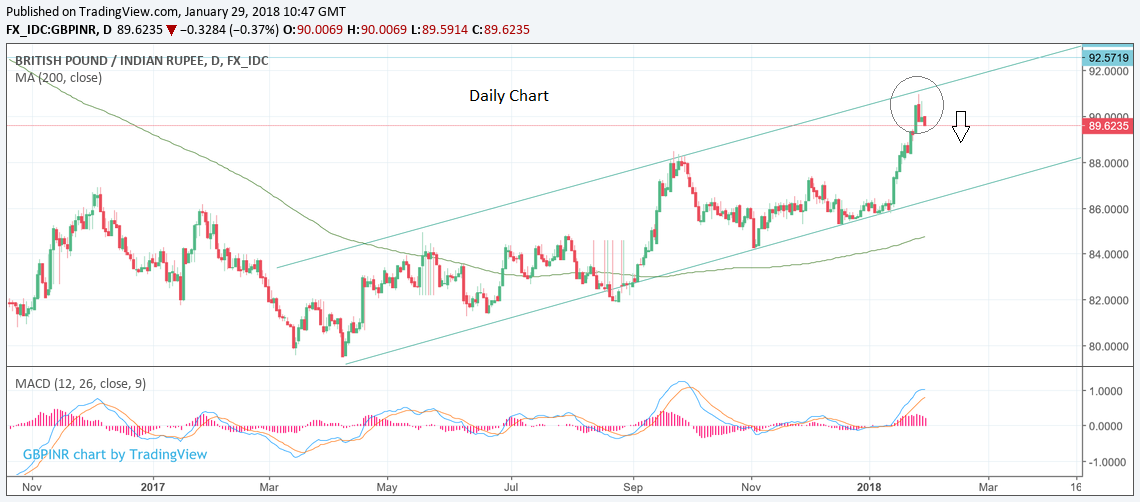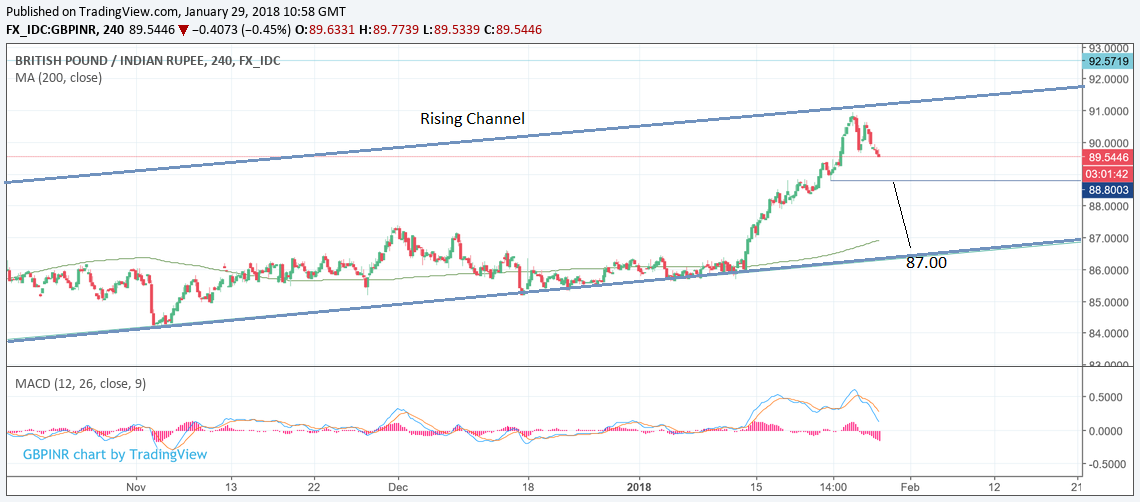Pound vs. Indian Ruppee Forecast for the Week Ahead

A temporary pull-back for GBP/INR could be on the cards, although the longer-term trend remains bullish.
The Pound-to-Rupee exchange rate is rising within a channel in an uptrend overall but there are signs it may have peaked and could be reversing.
The exchange rate has reached the top of the channel and has pulled-back a bit, the question now is, is the pull-back part of a new down move back towards the channel lows, or is it just a correction before the exchange rate moves higher again.

The upper channel line is likely to act as a tough obstacle to further upside due to technical traders entering the market at that level and selling in anticipation of a move back down.

The path of least resistance is lower, although there is, as yet, insufficient evidence that a new short-term downtrend has started and we would need to see a break below the 88.93 swing lows, visible on the four-hour timeframe, for confirmation of more downside to a target at the lower channel line of 87.00.

Get up to 5% more foreign exchange by using a specialist provider to get closer to the real market rate and avoid the gaping spreads charged by your bank when providing currency. Learn more here.
Data and Events for the Indian Rupee
The main event for the Rupee in the week ahead is the Federal Budget, released on Thursday, February 1.
The main focus for Rupee-watchers will be how the budget impacts on the budget balance and whether it is likely to deepen the deficit due to increased spending or reduce it due to purse-tightening.
The government is expected to steer a middle way between growth-orientated fiscally expansive policies and prudence, which if true will probably be positive for the currency, according to DBS economist Radhika Rao.
An important gauge of Indian Manufacturing is also out on Thursday (at 5.00 GMT) - the Nikkei Manufacturing PMI gauge - and this is forecast to show a rise in December to 54.7 from 53.8 previously.
Data and Events for the Pound
The main data release in the week ahead for the Pound is survey data for Manufacturing and Construction in January, in the form of Markit IHS's purchasing manager indices (PMIs).
These are normally a reliable forward indicator of activity and trends within the broader economy and economists use them to predict growth. Markets will be looking for confirmation that the better-than-forecast economic momentum enjoyed by the UK economy in the final quarter of 2017, confirmed in last week's GDP data, has extended into the new year.
Manufacturing PMI is out at 9.30 GMT on Thursday, February 1 and is expected to rise to 56.5 from 56.3 previously.
Global investment bank TD Securities say economists are being too optimistic about Manufacturing and the index will fall to 55.9 instead of rising to 56.5; an outcome that would certainly weigh on the Pound we believe.
"We’re looking for a modest pullback in the manufacturing PMI after last month’s larger nearly 2pt decline, with the index falling from 56.3 to 55.9 in January. We expect to see some of the weakness in the flash Eurozone print reflected in the UK outcome," say TD Securities in a briefing to clients ahead of the new week.
Construction PMI is out at the same time on the following day and is forecast to fall to 52.0 from 52.2 in December. Note that the sector is in recession, according to official GDP data, so some recovery will be keenly anticipated. However, construction is a small component of the UK economy and the impact on Sterling will likely be small if any. Nevertheless, clues on longer-term prospects for the economy will be key for overall sentiment.
One further event of interest to Pound-watchers in the week ahead is Bank of England (BOE) governor Mark Carney's testimony to the Lord's Economic Affairs Committee at which he will have the opportunity to comment on the state of the economy and monetary policy before the 'black-out' period prior to the next official BoE rate meeting.
Markets are keen to ascertain whether or not the BOE will raise interest rates in 2018, in a follow up to 2017's rate rise. Markets are anticipating this is the case, but a bullish assessment by Carney could certainly be the catalyst to a higher Sterling in the coming week we believe.
Carney's appearance in Davos last week was striking in that he hinted that he is taking a more optimistic stance on the UK economy, seeing growth picking up sharply towards the end of the year as the UK "consciously recouples" with the accelerating global economy.
He will certainly be queried on this, and the answers will be closely followed by currency traders.
Get up to 5% more foreign exchange by using a specialist provider to get closer to the real market rate and avoid the gaping spreads charged by your bank when providing currency. Learn more here.






